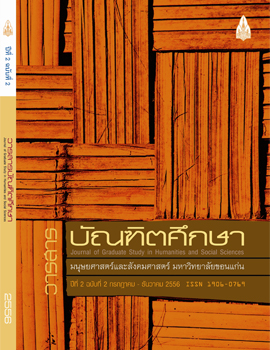Developing Web-based Lessons on Collocations for Khon Kaen University Students
คำสำคัญ:
การปรากฏร่วมของคำ, บทเรียนผ่านเว็บ, มูเดิล, Collocations, Web-based lessons, Moodleบทคัดย่อ
งานวิจัยนี้มีวัตถุประสงค์เพื่อศึกษาผลสัมฤทธิ์การเรียนรู้เรื่องการปรากฏร่วมของคำของนักศึกษา มหาวิทยาลัยขอนแก่น โดยการเรียนรู้ผ่านสื่อบทเรียนผ่านเว็บ และศึกษาทัศนคติของนักศึกษาที่มีต่อบทเรียนผ่านเว็บ กลุ่มตัวอย่างที่ใช้ในการวิจัยครั้งนี้คือ นักศึกษาสาขาวิชาภาษาอังกฤษ ชั้นปีที่ 2 คณะมนุษยศาสตร์และสังคมศาสตร์ มหาวิทยาลัยขอนแก่น จำนวน 33 คน ที่ลงทะเบียนเรียนในรายวิชา 411 242 การเขียนภาษาอังกฤษ 2 ในภาคการศึกษาที่ 2 ปีการศึกษา 2555 เครื่องมือที่ใช้ในวิจัยได้แก่ 1) แบบทดสอบก่อนเรียนและหลังเรียน 2) บทเรียนผ่านเว็บ เรื่องการปรากฏร่วมของคำ3) แบบสอบถาม และ 4) แบบสัมภาษณ์ ผู้วิจัยใช้โปรแกรม SPSS ในการวิเคราะห์ข้อมูลทางสถิติเพื่อหาค่าร้อยละ (percentage) ค่าเฉลี่ย (mean) ส่วนเบี่ยงเบนมาตรฐาน (S.D.) และการทดสอบค่าที (t-Test) นอกจากนี้ ผู้วิจัยได้ใช้สูตร Kuder–Richardson (KR-20) เพื่อหาค่าความเชื่อมั่นของแบบทดสอบก่อนเรียน และหลังเรียน อีกทั้งยังเลือกใช้วิธีการวิเคราะห์ข้อมูลเชิงเนื้อหาในการวิเคราะห์แบบสัมภาษณ์ ผลการวิจัยพบว่า คะแนนเฉลี่ยจากแบบทดสอบหลังเรียนบทเรียนผ่านเว็บ เรื่องการปรากฏร่วมของคำสูงกว่าคะแนนเฉลี่ยจากแบบทดสอบก่อนเรียน อย่างมีนัยสำคัญที่ระดับ 0.0 นอกจากนี้ยังพบว่า มีการใช้การปรากฏร่วมของคำที่อยู่ในบทเรียนผ่านเว็บเพิ่มมากขึ้นในแบบทดสอบการเขียนหลังเรียน ส่วนคะแนนเฉลี่ยในแบบฝึกหัดของผู้เรียน เรื่องการปรากฏร่วมของคำในบทเรียนผ่านเว็บ พบว่า อยู่ในระดับสูง ส่วนค่าดัชนีประสิทธิผล คือ .68 และจากการวิเคราะห์แบบสอบถามและแบบสัมภาษณ์ พ ว่า ผู้เรียนมีทัศนคติในเชิงบวกต่อการเรียนบทเรียนผ่านเว็บ เรื่องการปรากฏร่วมของคำ โดยเห็นว่าบทเรียนและแบบฝึกหัดผ่านเว็บมีประโยชน์ สนุกและน่าสนใจ เสริมสร้างการเรียนรู้และพัฒนาทักษะทา ภาษา พร้อมเสนอแนะให้มีการนำบทเรียนผ่านเว็บไปใช้กับรายวิชาอื่นๆ อีกด้วย
การพัฒนาบทเรียนผ่านเว็บ เรื่องการปรากฏร่วมของคำสำหรับนักศึกษามหาวิทยาลัยขอนแก่น
This study aims to study the achievement of KKU students’ knowledge of collocations by learning through web-based lessons and to investigate students’ attitudes towards web-based lessons on collocations. The participants of the study were 33 second year English major students who enrolled in 411 242 English Writing II in the second semester of academic year 2012 at the faculty of Humanities and Social Sciences in Khon Kaen University. The research instruments were comprised of 1) the pretest and the posttest, 2) web-based lessons on collocations, 3) the questionnaire, and 4) the interview. SPSS program was employed to analyze the statistics including the percentage, mean (x¯), standard deviation (S.D.), and t-Test. In addition, Kuder–Richardson (KR-20) formula was used to find the reliability of the pretest and the posttest (collocation test at a sentence level). Content analysis was also employed to analyze the interview. The findings of the study showed that the mean score of the collocation test at a sentence level in the posttest was significantly higher than that of the pretest at p < 0.05 level. Moreover, the collocation used in students’ writing in the posttest was higher than in the pretest. The mean score of participants’ exercises of collocations was considered at a high level, and the effectiveness index (E.I.) was 0.68. In addition, from the analysis of the questionnaire and the interview, the study found that students had positive attitudes towards web-based lessons on collocations. They revealed that web-based lessons were useful, fun, and interesting for enhancing their knowledge and language proficiency. Students also recommended that web-based lessons were suitable to be integrated as a part of other courses.







